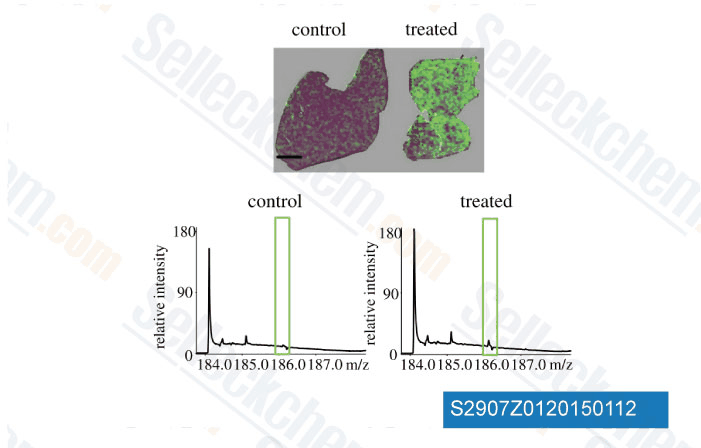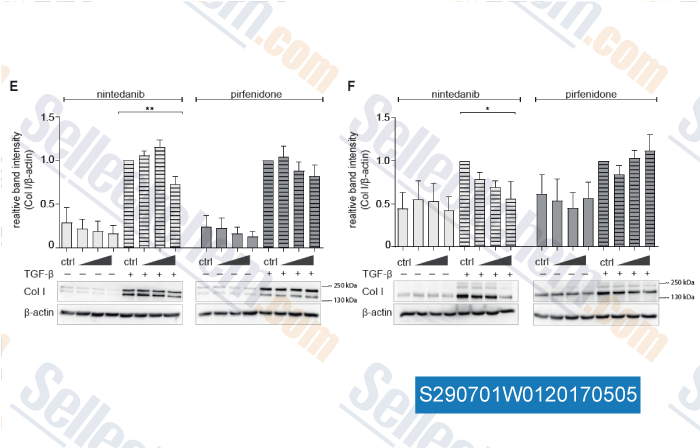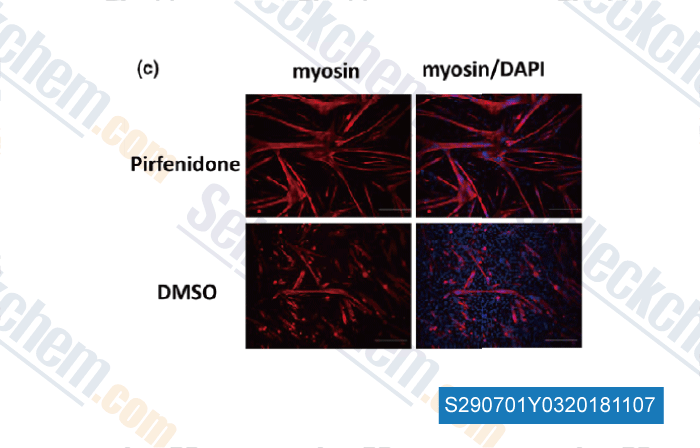|
Toll Free: (877) 796-6397 -- USA and Canada only -- |
Fax: +1-832-582-8590 Orders: +1-832-582-8158 |
Tech Support: +1-832-582-8158 Ext:3 Please provide your Order Number in the email. |
Technical Data
| Formula | C12H11NO |
|||
| Molecular Weight | 185.22 | CAS No. | 53179-13-8 | |
| Solubility (25°C)* | In vitro | DMSO | 37 mg/mL (199.76 mM) | |
| Ethanol | 37 mg/mL (199.76 mM) | |||
| Water | 16 mg/mL (86.38 mM) | |||
|
* <1 mg/ml means slightly soluble or insoluble. * Please note that Selleck tests the solubility of all compounds in-house, and the actual solubility may differ slightly from published values. This is normal and is due to slight batch-to-batch variations. * Room temperature shipping (Stability testing shows this product can be shipped without any cooling measures.) |
||||
Preparing Stock Solutions
Biological Activity
| Description | Pirfenidone is an inhibitor for TGF-β production and TGF-β stimulated collagen production, reduces production of TNF-α and IL-1β, and also has anti-fibrotic and anti-inflammatory properties. Pirfenidone attenuates chemokine (CC motif) ligand-2 (CCL2) and CCL12 production with anti-fibrotic activity. Phase 3. | |
|---|---|---|
| Targets |
|
|
| In vitro | Pirfenidone (< 300 μg/mL) suppresses the proinflammatory cytokine tumor necrosis factor-α (TNF-α) by a translational mechanism in RAW264.7 cells, which is independent of activation of the mitogen-activated protain kinase (MAPK) 2, p38 MAP kinase, and c-Jun N-terminal kinase (JNK). [1] Pirfenidone (< 10 mM) leads to reduced glioma cell density in concentration-dependent manner in LN-18, T98G, LNT-229 and LN-308 cell lines. Pirfenidone (< 5 mM) reduces TGF-β bioactivity by affecting TGF-β2 mRNA expression and processing of pro-TGF-β in CCL-64 cells. Pirfenidone (< 8.3 mM) inhibits the activity of recombinant furin and downregulates the expression of MMP-11 in a dose-dependent manner in LN-308 cells. [2] |
|
| In vivo | Pirfenidone (250 mg/kg) potently inhibits the production of the proinflammatory cytokines, TNF-alpha, interferon-gamma, and interleukin-6, but enhances the production of the anti-inflammatory cytokine, interleukin-10, in mice. [1] Pirfenidone (250 mg/kg/day) ameliorates cyclosporine-induced fibrosis by about 50% and decreases TGF-beta1 protein expression by 80% in Sprague-Dawley rats receiving a low-salt diet. [3] Pirfenidone (400 mg/kg/day) inhibits heat shock protein 47-positive cells and myofibroblasts, the principal cells responsible for the accumulation and deposition of extracellular matrix seen in pulmonary fibrosis in ICR mice intravenously injected with bleomycin. [4] Pirfenidone (0.5%, liquid diet) treatment reduces the degree of liver injury in rats, as determined by alanine aminotransferase values and necro-inflammatory score, which is associated with reduced hepatic stellate cells proliferation and collagen deposition. Pirfenidone (0.5%, liquid diet) administration downregulates dimethylnitrosamine induced transcripts levels of procollagen alpha1(I), TIMP-1 and MMP-2 by 50-60% in rats, and this is associated with a 70% reduction in collagen deposition. [5] |
Protocol (from reference)
| Cell Assay: |
|
|---|---|
| Animal Study: |
|
References
Customer Product Validation

-
Data from [Data independently produced by Histochem Cell Biol, 2014, 142(4), 361-71]

-
, , Am J Respir Cell Mol Biol, 2017, 57(1):77-90

-
Data from [Data independently produced by , , Aging Cell, 2018, doi: 10.1111/acel.12788]
Selleck's Pirfenidone has been cited by 46 publications
| Repositioning of ezetimibe for the treatment of idiopathic pulmonary fibrosis [ Eur Respir J, 2024, 2300580] | PubMed: 38359963 |
| Modulation of Extracellular Matrix Composition and Chronic Inflammation with Pirfenidone Promotes Scar Reduction in Retinal Wound Repair [ Cells, 2024, 13(2)164] | PubMed: 38247855 |
| Fisetin ameliorates fibrotic kidney disease in mice via inhibiting ACSL4-mediated tubular ferroptosis [ Acta Pharmacol Sin, 2023, 10.1038/s41401-023-01156-w] | PubMed: 37696989 |
| Macrophage activity at the site of tumor ablation can promote murine urothelial cancer via transforming growth factor-β1 [ Front Immunol, 2023, 14:1070196] | PubMed: 36761730 |
| Differences in Treatment Response in Bronchial Epithelial Cells from Idiopathic Pulmonary Fibrosis (IPF) Patients: A First Step towards Personalized Medicine [ Antioxidants (Basel), 2023, 12(2)443] | PubMed: 36830000 |
| Differences in Treatment Response in Bronchial Epithelial Cells from Idiopathic Pulmonary Fibrosis -IPF) Patients: A First Step towards Personalized Medicine [ Antioxidants -Basel), 2023, 12(2)443] | PubMed: 36830000 |
| Impact of in vitro HIV infection on human thymic regulatory T cell differentiation [ Front Microbiol, 2023, 14:1217801] | PubMed: 37547675 |
| Establishment and characterization of immortalized sweat gland myoepithelial cells [ Sci Rep, 2022, 12(1):7] | PubMed: 34997030 |
| The Anti-fibrosis drug Pirfenidone modifies the immunosuppressive tumor microenvironment and prevents the progression of renal cell carcinoma by inhibiting tumor autocrine TGF-β [ Cancer Biol Ther, 2022, 23(1):150-162] | PubMed: 35130111 |
| Contracting scars from fibrin drops [ Integr Biol (Camb), 2022, 14(1):1-12] | PubMed: 35184163 |
RETURN POLICY
Selleck Chemical’s Unconditional Return Policy ensures a smooth online shopping experience for our customers. If you are in any way unsatisfied with your purchase, you may return any item(s) within 7 days of receiving it. In the event of product quality issues, either protocol related or product related problems, you may return any item(s) within 365 days from the original purchase date. Please follow the instructions below when returning products.
SHIPPING AND STORAGE
Selleck products are transported at room temperature. If you receive the product at room temperature, please rest assured, the Selleck Quality Inspection Department has conducted experiments to verify that the normal temperature placement of one month will not affect the biological activity of powder products. After collecting, please store the product according to the requirements described in the datasheet. Most Selleck products are stable under the recommended conditions.
NOT FOR HUMAN, VETERINARY DIAGNOSTIC OR THERAPEUTIC USE.
